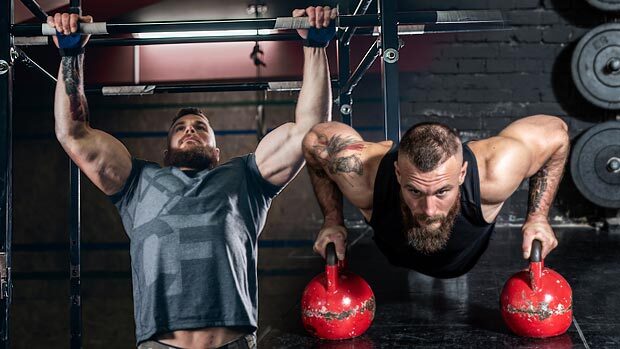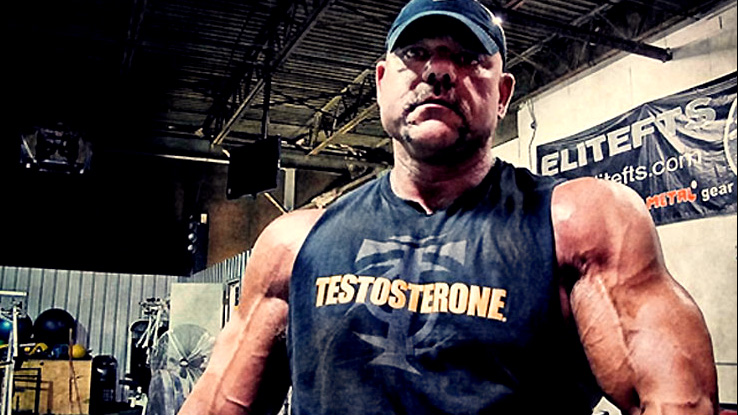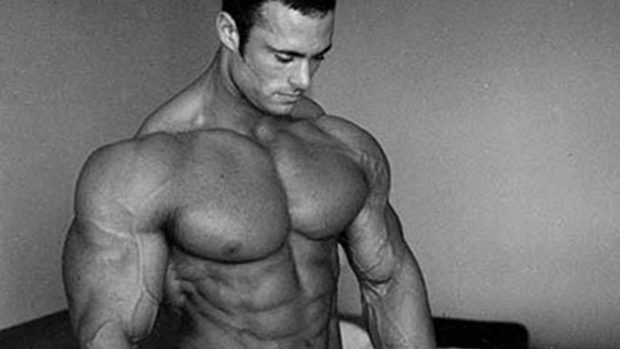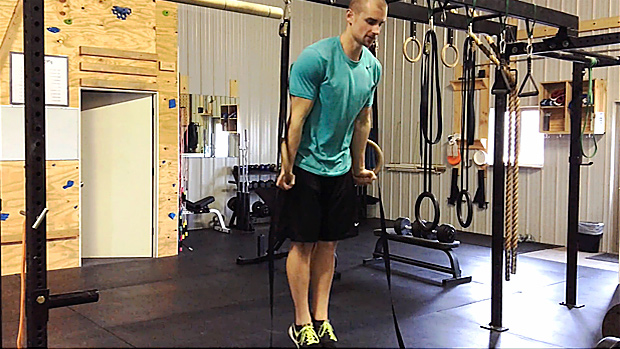Push-ups and chin-ups increase your relative strength. Relative strength is what determines your ability to move your body through space. It's your strength compared to your size.
While most training programs build absolute strength through the classic barbell lifts, they often pay little attention to increasing relative strength. No matter your goals, push-ups and chin-ups should be a staple in your program. Your arms will grow, your back will blow up, your pecs will pop, and you'll have forearms like Popeye.
Relative Strength Standards
- Every man should be able to pump out at least 20-30 unbroken push-ups and 5-10 chin-ups.
- Every woman should aim to do at least 5-10 unbroken push-ups and 2-4 chin-ups.
If you've been working out consistently for a few years and can't do this, it's time to readjust your approach to training (and possibly recovery). Use push-ups and chin-ups as indicator lifts to measure your progress over time.
Here are six ways to take your push-ups and chin-ups to the next level. Pick one method and train it 1-2 times per week for 3-4 weeks at a time. Then move onto another. You'll give your body enough time to adapt to the new stresses while finding what works for you and your goals.
1. Engage Your Core
Contrary to popular belief, push-ups and chin-ups don't just work your arms. They require full-body tension to get the most out of them. Tension increases your strength potential and ability to generate force.
Think about the last time you did a heavy bench or squat. Were you loosey-goosey during your set? Probably not. Same thing goes for bodyweight exercises. If you're a wet noodle when you do them, you won't get as many of the benefits.
Here's how to engage your core
- Have a very slight posterior pelvic tilt to maintain a flat or "neutral" lower back (think sad dog tucking its tail between its legs).
- Squeeze your glutes.
- Keep your ribs down and core tight. Imagine bracing before getting punched in the gut.
2. Do Isometrics
Isometric reps are when your muscles are under load with no change in joint angle. You hold a position. They improve your exercise positioning and muscle recruitment while increasing your muscles' total time under tension.
Whether you're training to do your first push-up or chin-up, or you want to take them to the next level, isometrics help build base-level strength.
Isometric Chin-Up
- Pull yourself up to the top with your chin over the bar and hold.
- Squeeze your armpits together and keep a "proud" chest.
- Maintain full-body tension and don't move.
Isometric Push-Up
- Start in a full push-up position and lower yourself until your chest is an inch off the floor.
- Hold the bottom of the push-up and maintain full-body tension.
Since no movement is involved during the isometric hold, there's little to no wear and tear on your joints. What's more, they're a great way to practice optimal technique and increase muscle recruitment.
Try holding each rep for 30-60 seconds, or do multiple reps with shorter holds.
3. Do Slow Eccentrics
An eccentric rep is when your muscles lengthen under load, like they would during the lowering part of a push-up or chin-up. Since you're stronger during the eccentric phase, you can handle more load and time under tension (TUT).
Slow Eccentric Push-Up
- Get into a full push-up position.
- Lower yourself slowly until your body is fully rested on the floor.
Slow Eccentric Chin-Up
- Pull yourself up (or jump to the top) with your chin over the bar.
- Lower yourself slowly until you're at a complete dead hang.
Use slow eccentric reps to overload your muscles by focusing solely on the lowering portion. Try 20-30 second eccentric reps or perform multiple reps with shorter eccentric phases.
4. Do Positional Isometrics
Positional isometrics are when you add segmented pauses throughout an exercise's range of motion (during the eccentric and/or concentric phases).
Positional Isometric Push-Up
- Start in a full push-up position. Lower yourself halfway down and hold.
- Lower yourself fully with your chest an inch off the floor and hold.
- Push back halfway up and hold again.
- Push back up to your starting position and repeat.
Positional Isometric Chin-Up
- Start in a dead hang and pull yourself up halfway so your arms are at a 90-degree angle. Hold it there.
- Pull yourself up fully with your chin over the bar and hold.
- Lower yourself back down halfway and hold again.
- Lower yourself fully to a complete dead hang and repeat.
These are friggin' brutal. Positional isometrics also strengthen your sticking points. While isometric contractions involve static positions, strength increases occur at roughly 10-degrees of either side of the joint angle (1). So if you feel weakest at the bottom or middle of your push-up or chin-up, adding pauses in these areas will increase your ability to push or pull through them.
5. Do Full-Stop Reps
Full-stop or dead-stop reps are when you come to a complete halt at the end of each rep (between the eccentric and concentric phases). They reduce momentum, keep you true to your form, and improve your ability to generate force.
Full Stop Push-Up
- Start in a full push-up position and lower your chest to the floor.
- Stop completely with your chest in contact with the floor.
- Push yourself back up and repeat.
To do these optimally, your body should come up as one tight unit.
Full Stop Chin-Up
- Hold the chin-up bar with your feet in contact with the floor (if you can't reach the bar, stand on a plate or riser).
- Do a chin-up and lower yourself back down all the way to a full stop with your feet on the floor.
When you fatigue during chin-ups, the common tendency is to swing and use body English to get up, but you don't get stronger using momentum to your advantage. Full-stop reps eliminate this from happening and force you to use optimal technique to complete your set.
6. Do Weighted Reps
If you're a beast, add resistance. You can do this with a belt (for chin-ups), weight vest, dumbbell, plate, band, or give someone a piggyback.
Weighted Chin-Up
-
Banded Push-Up
Putting It All Together
The training modalities you use to improve your push-ups and chin-ups are dependent on your individual goals and capabilities.
- No matter what, engage your core and maintain tension throughout your set.
If you're having trouble with your technique or want to strengthen your sticking points, use isometrics or positional isometrics. - Eccentrics overload the lowering phase so you can get stronger during the concentric phases of both exercises.
- Dead-stop reps are a great way to practice optimal technique and increase your ability to generate force.
- When all is said and done, adding load is a surefire way to get stronger.
Reference
- Physical Rehabilitation; Evidence-Based Examination, Evaluation, and Intervention by Michelle H. Cameron, Linda Monroe





